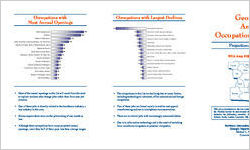Occupations with Most Annual Openings
Retail Salespersons Cashiers
Waiters & Waitresses Comb. Food Prep. & Serving Workers, Incl. Fast Food
Laborers & Freight, Stock, & Material Movers, Hand Registered Nurses
Stock Clerks & Order Fillers Elementary School Teachers, Ex. Spec. Ed.
Teacher Assistants Farmers & Ranchers General & Operations Managers Truck Drivers, Heavy & Tractor-Trailer Office Clerks, General Packers & Packagers, Hand
Team Assemblers
80 80 80 70 60 50 50 50 40 40 40
130 120
220 200
Most of the annual openings in this list will result from the need to replace workers who change jobs rather than from new job creation.
One of these jobs is directly related to the healthcare industry, a key industry in this area.
Eleven require short-term on-the-job training of one month or less.
Although these occupations have many projected annual openings, more than half of them pays less than average wages.
Occupations with Largest Declines
-160
-50 -50
-40 -40 -40
-30 -30 -30 -30 -30
-20 -20 -20 -20
Sew ing Machine Operators Farm, Ranch, & Other Agricultural Managers Secretaries, Except Legal, Medical, & Executive Inspectors, Testers, Sorters, Samplers, & Weighers Order Clerks Railroad Brake, Signal, & Sw itch Operators Bookkeeping, Accounting, & Auditing Clerks Cut., Punch., & Press Mach. Setrs., Opers., & Tndrs., Metal & Plastic Dishw ashers Suprvsrs. of Farming, Fishing, & Forestry Workers Sw itchboard Operators, Incl. Answ ering Service Computer Operators Graders & Sorters, Agricultural Products Insurance Claims & Policy Processing Clerks Loan Interview ers & Clerks
The occupations in this list are declining due to many factors, including technological advances, office automation and foreign competition.
Two of these jobs are found mainly in textiles and apparel manufacturing and one is in telephone communications.
Three are in clerical jobs with increasingly automated duties.
One is in information technology and is the result of switching from mainframe computers to personal computers.
Georgia Area
Occupational Trends
Projections to 2010
WIA Area #18 South GA
This area encompasses the ten counties of central South Georgia near the Florida border in and around the cities of Tifton and Valdosta. It includes the following counties: Ben Hill, Berrien, Brooks, Cook, Echols, Irwin, Lanier, Lowndes, Tift, and Turner.
Workforce Information & Analysis Division Georgia Department of Labor Michael L. Thurmond Commissioner
Total employment in WIA Area #18 is expected to reach more than 120,000 jobs by the year 2010, with more than 1,500 new jobs added each year. While the area's economy is currently not growing as fast as Georgia's overall, it is growing at the same rate as the nation's economy. Area job growth is expected to be 1.4 percent per year, while Georgia's job growth is expected to be 1.8 percent per year.
Area Highlights
This area is the home of a regional medical center and a regional university.
Thanks to its agricultural experiment station at Tifton, it is also home to one of the largest concentrations of Ph.D.'s per capita in the United States.
Key industries include health services, educational services, agricultural production, lumber and wood products, and apparel and other textile products.
This area experienced a 15.9 percent population growth rate over the period from 1990 to 2000 as compared to a statewide rate of 25.8 percent over the same period.
Total personal income grew by 77.0 percent over the 10-year period while Georgia total personal income grew by 98.2 percent.
For copies of the Georgia Career Planner, Georgia Occupational Trends in Brief
or this publication, call 404/232-3875 or contact your local
Department of Labor office.
Fastest Growing Occupations
Registered Nurses Nursing Aides, Orderlies, & Attendants
Teacher Assistants Comb. Food Prep. & Serving Workers, Incl. Fast Food
Child Care Workers Cashiers
Waiters & Waitresses Farmers & Ranchers Retail Salespersons Office Clerks, General Packers & Packagers, Hand General & Operations Managers Elementary School Teachers, Ex. Spec. Ed. Truck Drivers, Heavy & Tractor-Trailer Laborers & Freight, Stock, & Material Movers, Hand
2.6% 2.3% 1.9% 1.7% 1.6% 1.5% 1.1% 1.1% 1.1% 0.9% 0.9% 0.8% 0.8% 0.8% 0.6%
These fast-growing occupations will have better employment prospects than occupations with slow or declining employment. Also, conditions will be more favorable for mobility and advancement.
One of the fastest growing occupations is associated with the healthcare industry.
Two are found mainly in the K-12 educational services industry.
Four of these jobs are found mainly in the retail trade industry.
Occupations with Largest Job Growth
Retail Salespersons Cashiers
Registered Nurses Comb. Food Prep. & Serving Workers, Incl. Fast Food
Waiters & Waitresses Teacher Assistants
Customer Service Representatives Farmers & Ranchers
Truck Drivers, Heavy & Tractor-Trailer Nursing Aides, Orderlies, & Attendants Elementary School Teachers, Ex. Spec. Ed. Laborers & Freight, Stock, & Material Movers, Hand
General & Operations Managers Suprvsrs. of Retail Sales Workers
Stock Clerks & Order Fillers
840 640 490 410 370 310 300 290 290 270 240 230 210 200 190
These 15 occupations out of more than 700 - are projected to add about 5,300 jobs over the next 10 years, about 34 percent of all projected job growth in this area.
Ten occupations require short-term on-the-job training of one month or less and three require a college degree.
Twelve of these occupations do not require any formal education beyond high school.
Equal Opportunity Employer/Program Auxiliary Aids and Services Available upon Request to Individuals with Disabilities
